

| Camiguin, an unspoiled paradise | |
Surigao (Philippines), July 18th 2012
|
|
|
|
|
Camiguin is an example of a destination that shouldn’t be missed when you bring a visit to the southern part of the Philippines. This relatively unspoiled little island, with the highest density of volcanoes in the world, is a real paradise. The Lonely Planet travel guide is even more enthusiastic. They say that Camiguin in on par with islands like Hawaii and Maui, but then unspoiled. So, we decided to go to look for ourselves. We took the local ferry from the small harbour of Balingoan, located on the north coast of Mindanao, somewhere between the towns of Cagayan de Oro and Butuan. Camiguin is already visible from this harbour, but the closer you get to the island, the more spectacular the view is. The imposing silhouette of Camiguin rises from the sea and the clouds that obscure the top of the Hibok-Hibok volcano gives the island a mysterious character. The journey from Balingoan to Benoni, a small harbour settlement on Camiguin Island, takes a little more than an hour. On arrival, a couple of jeepneys are waiting at the harbour, to take the passengers to Mambajao, the only real town on the island. The ride takes 30 minutes and is a good introduction to the beauty of the island. Small villages and clear blue bays take turns and on some places the island is flat enough for the farmers to grow rice. |
|
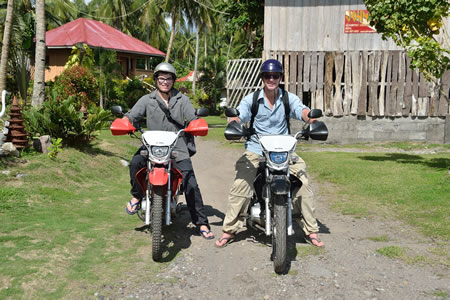 |
|
Ready to explore Camiguin |
|
In Mambajao, we arrange a tricycle (a motorcycle with sidecar for approximately 4 persons), to take us to a resort, located five kilometres from Mambajao. The first resort that we check is too expensive in our opinion. We walk to the next one and eventually we check in at the nearby Seascape resort. But don’t think that this is a western style resort. The rooms are 500 Pesos (Euro 10) and for this amount we get a very basic but clean room in a bungalow with veranda. And, the setting is perfect. We are within 20 metres of a small volcanic beach with black sand, and from our veranda we can enjoy the spectacular sunsets. Our travel mates Jorn and Robin can’t resist the sea, and almost before we put our backpacks on the ground, they changed their clothes into trunks. This is the reason to come to the Philippines! For the days on Camiguin, we hire three motorcycles to explore the island. For 350 Pesos a day (Euro 7), we have a fierce 125 cc Honda motorcycle to our disposal. Ivonne and I share a motorcycle, while the boys decide to take one for their own. Camiguin is a perfect place to explore by motorcycle. The island is small enough (the road around the island is only 65 kilometres long) to drive around is one day. Also the traffic is very quiet, which means that even the less experienced drivers, or drivers without a motorcycle driving license, will feel comfortable hiring a motorcycle. But of course, it is still wise to be careful because the bending roads, the coconut shells on the streets and once in a while a slow water buffalo, can surprise even the most experienced drivers. |
|
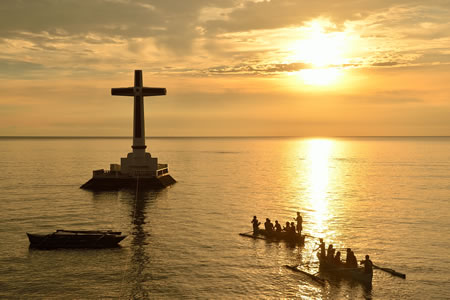 |
|
The 'sunken cemetery' snorkeling spot |
|
| We use the first full day on Camiguin to drive around the island. We stop once in a while to make pictures or to drink a soft drink at one of the many sari-sari shops (very small village shops/booths with often only an opening of around 40x40 centimetres, which sell the most basic necessities). We stop also at ‘Cantaan Kabila White Beach’, where some of the best coral of the island can be founds. The area in front of this beach is also a small marine reserve where they protect and reproduce giant clams, which can be observed well with snorkelling gear. A couple of kilometres further, there is an inland road that leads to the Binangawan Falls. But after a couple of kilometres, we have to turn around because the road was to muddy. It was difficult to keep the motorcycles under control, so we decided to drive back to the main road. Ten kilometres before we reached the resort again, we stopped again for a snorkel session at the Sunken Cemetery. Ivonne and I took care of the things, while Robin and Jorn went into the water to check the place. They didn’t find any evidence of the cemetery, of which is said that it sank under the water after an earthquake, but the coral was reasonable.
During the second full day of our visit to Camiguin, we explored the interior of the island. We drove up as far as possible on the Hibok-Hibok volcano, but at an altitude of around 550 metres, the road suddenly stopped. But the views to the top of the volcano were beautiful. After we drove down to sea level again, we did some shopping at a supermarket in Mambajao and had lunch at a place where they had great pizzas. We filled our stomachs and went to the Stations of the Cross, a short pilgrimage walk up the hill from where the views were nice. Our last main activity on this island was a visit to the Ardent Hot Springs, a great place to ‘cool down’ a little bit after the heavy walk uphill. In the evening, we spent some hours on our veranda to enjoy a cold beer, a great sunset and to end our enjoyable visit to Camiguin. The next morning we took the ferry back to Mindanao, to continue our travel eastwards to the surf destination Siargao (see also the article: The beach bumps and us). |
|
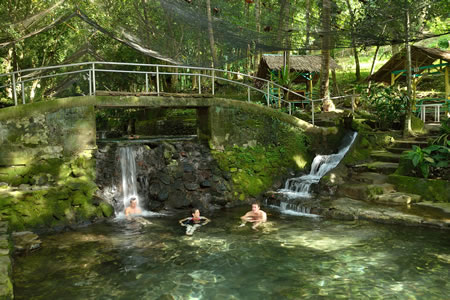 |
|
Cooling down at the Ardent Hot Spring |
|
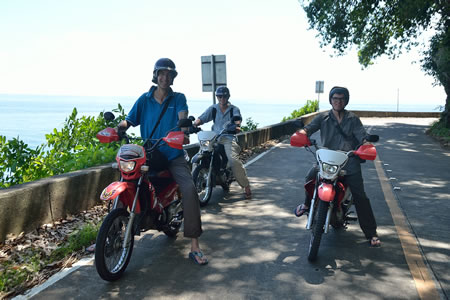 |
|
The Hells Angels of Camiguin |
|
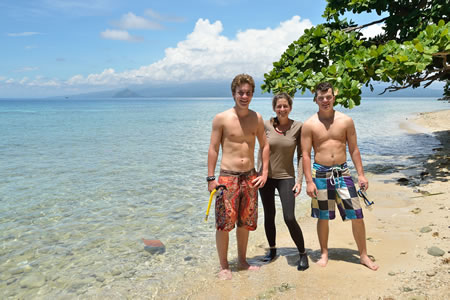 |
|
Snorkeling for giant clams at ‘Cantaan Kabila White Beach’ |
|
 |
|
The Seascape resort and our bungalow |
|
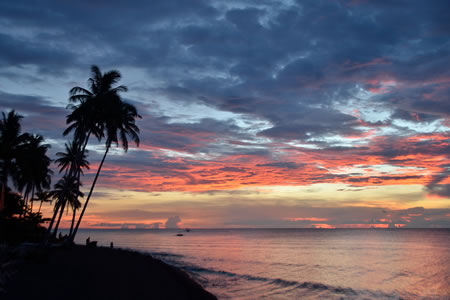 |
|
Sunset as seen from our veranda © copyright - Babakoto.eu / 2012 |
|